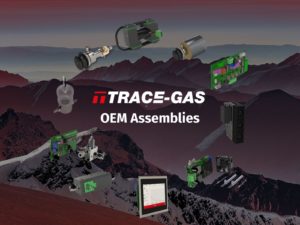Possible applications for the compact TRACE-GAS LASmini sensors in monitoring ammonia emissions (NH3) in agriculture.
In the field next to KNESTEL’s company building in rural Allgäu, a farmer spreads liquid manure. The smell of ammonia fills the hallways and one wonders if the gas has other negative impacts, such as on our environment, besides the enormous odor nuisance.
The worldwide NH3 emissions originate for the most part from agriculture. However, according to recent studies, despite increased use of fertilizers (liquid manure, nitrogen fertilizers), there is a decreasing efficiency in yields. By monitoring the gas concentrations, especially in stables, a reduction of NH3 emissions can be achieved. A positive side effect is the improved stable climate, which contributes significantly to the welfare of the animals.
The measurement of ammonia is an exciting field of application for laser absorption spectroscopy (LAS/TDLS). The LASmini technology platform from TRACE-GAS is ideal for emission monitoring due
to its compact design. The underlying LAS technology is a selective measurement method that can detect a wide range of molecules at very low concentrations (ppb), including NH3.
With LAS, the wavelength of the radiation source is selected according to the gas to be measured. This offers the possibility to realize the physically traceable principle on the basis of the existing setup for the measurement of various gases (e.g. N2O, H2O2, …). For this purpose, the basic setup is adapted by exchanging the laser source and the detector, which allows the sensor technology to be used in numerous applications.
Due to the introduction of Adblue® technology in exhaust gas cleaning systems, ammonia detection is also useful in the automotive industry or in industrial DeNOx systems. The advantage of using the LASmini technology is the possibility of a direct measurement in hot and humid exhaust gases.
In the future, research and development in the automotive sector will focus on alternative fuels in addition to a switch to electrified vehicles, with hydrogen (H2) in particular being considered promising. Ammonia is also being discussed as an energy carrier, or more precisely as a storage and transport medium, for hydrogen.
Due to continuous developments and new findings, new interesting application possibilities for the flexible LASmini modules arise again and again, not only in the field of ammonia monitoring.
You can also find more info about the technology here: https://www.trace-gas.com/technology-las-pas-cld-ndir/laser-absorption-spectroscopy/



